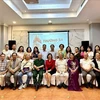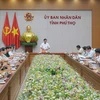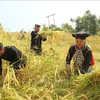In recent days, many major French newspapers are running articles protesting against China’s unjustified hegemony and its illegal placement of the oil rig Haiyang Shiyoug-981 in the East Sea.
Radio The Voice of Vietnam (VOV) quoted a Le Figaro June 20 article as saying that with the deployment of China's second drilling rig last week, China continues to inflame island conflicts with Vietnam.
The same day, the l'Humanité newspaper also published an article about China’s decision to place another four rigs in the sea.
The article confirmed that China's actions increasingly show its territorial ambitions in the waters bordering with neighboring countries. It quoted a brazen declaration challenging the international public of Chinese Foreign Ministry spokesperson Hua Chunying as saying that everyone has the right to do everything in their house regardless of others’ concern.
Currently, two of four Chinese drilling rigs are located in offshore Hong Kong and another one is on its way to the area where China had installed wells five years ago.
The homepage of the Le Monde (the World) newspaper on June 23 had an article by correspondent in Southeast Asia Bruno Philip who conducted a recent fact-finding tour of the site where China illegally placed its drilling platform Haiyang Shiyou-981 in Vietnam’s exclusive economic zone (EEZ).
In his capacity as a witnesses on board a Vietnam Coast Guard ship, Philip realistically portrayed what he witnessed with his own eyes when Chinese vessels, with colours and specific codes, chased and threatened maritime safety for Vietnamese ships and how Vietnamese law enforcement forces managed to escape the "trap" of Chinese ships to avoid collisions and unnecessary damage, VOV reported.
Philip said China only confirmed its presence on the Hoang Sa (Paracel) since it occupied the archipelago in 1974, which earlier had been under the management of the Republic of Vietnam.
The article cited an affirmation by Vietnamese historian Tran Duc Anh Son saying that Vietnam had its full legal sovereignty from 1816 during the reign of King Gia Long which the Nguyen administration applied tax collection for fishermen in Hoang Sa.
In early 1920s, the French colonial government asserted its sovereignty over the archipelago with the construction of lighthouses and transmitting and receiving stations TSF on the Hoang Sa archipelago and a meteorological station on the Phu Lam Island (Boisee).
Although Vietnam has declared sufficient evidence to assert its sovereignty over the Paracel archipelago, China is stubbonly persisting with its misconduct against international law with the intention of "monopolising" the whole East Sea.
The author exposed Chinese slanderous accusations of Vietnamese ships of having "active collision" with Chinese vessels, and released footages of Chinese vessels firing water cannons against Vietnamese ships and sinking a Vietnamese fishing boat on May 26.
Also on June 23, the Le Monde newspaper carried a commentary by journalist Brice Pedroletti, affirming that China is imposing its conditions in the East Sea. The author stated that the recent actions by China with regional neighbours such as Japan, the Philippines and Vietnam are breaking the status quo and regional stability, and raising doubts and concern about this country’s "peaceful rise" fact.
The commentary cited a study by a Western expert as saying that China’s East Sea hegemony aims to meet four needs: First, finding a way out for high waters to serve fleets and strategic submarine bases in Hainan; second, protecting and controlling trade and shipping routes running through the area; third, ensuring security of natural resources, and oil and gas exploitation and exploration; and fourth, satisfying a section of public opinion which is nurturing Chinese nationalism.
The commentary ironically criticised "China’s dream" about "a great renaissance period" with Chinese claim over "U-shaped" line contrary to international law which faced international opposition.
The author also quoted researcher Yang Danzhi from the French Academy of Social Sciences as warning that China is trying to do something to carry out a "strategic opportunity era” with a political and economic environment conducive to China’s rise.
It is noteworthy that a French article for the first time commented on China's aggressive intentions.
The author quoted a statement by Zhang Jiangang, director of the China Maritime Strategy Research Centre under Guangdong Ocean University published on Global Times newspaper on June 15, as stating that China did not apply a rigid concept of peaceful development in defending sovereignty and territorial integrity as it used 10 percent of power and 90 percent of negotiations to resolve the conflicts. These show China’s increasingly aggressive acts in settling conflicts with other countries.
Last week radio station France Info broadcast for the first time a series of reportages by reporter Reltien Philippe who came to the position where China illegally placed its oil rig 981 in Vietnam’s EEZ.-VNA
Radio The Voice of Vietnam (VOV) quoted a Le Figaro June 20 article as saying that with the deployment of China's second drilling rig last week, China continues to inflame island conflicts with Vietnam.
The same day, the l'Humanité newspaper also published an article about China’s decision to place another four rigs in the sea.
The article confirmed that China's actions increasingly show its territorial ambitions in the waters bordering with neighboring countries. It quoted a brazen declaration challenging the international public of Chinese Foreign Ministry spokesperson Hua Chunying as saying that everyone has the right to do everything in their house regardless of others’ concern.
Currently, two of four Chinese drilling rigs are located in offshore Hong Kong and another one is on its way to the area where China had installed wells five years ago.
The homepage of the Le Monde (the World) newspaper on June 23 had an article by correspondent in Southeast Asia Bruno Philip who conducted a recent fact-finding tour of the site where China illegally placed its drilling platform Haiyang Shiyou-981 in Vietnam’s exclusive economic zone (EEZ).
In his capacity as a witnesses on board a Vietnam Coast Guard ship, Philip realistically portrayed what he witnessed with his own eyes when Chinese vessels, with colours and specific codes, chased and threatened maritime safety for Vietnamese ships and how Vietnamese law enforcement forces managed to escape the "trap" of Chinese ships to avoid collisions and unnecessary damage, VOV reported.
Philip said China only confirmed its presence on the Hoang Sa (Paracel) since it occupied the archipelago in 1974, which earlier had been under the management of the Republic of Vietnam.
The article cited an affirmation by Vietnamese historian Tran Duc Anh Son saying that Vietnam had its full legal sovereignty from 1816 during the reign of King Gia Long which the Nguyen administration applied tax collection for fishermen in Hoang Sa.
In early 1920s, the French colonial government asserted its sovereignty over the archipelago with the construction of lighthouses and transmitting and receiving stations TSF on the Hoang Sa archipelago and a meteorological station on the Phu Lam Island (Boisee).
Although Vietnam has declared sufficient evidence to assert its sovereignty over the Paracel archipelago, China is stubbonly persisting with its misconduct against international law with the intention of "monopolising" the whole East Sea.
The author exposed Chinese slanderous accusations of Vietnamese ships of having "active collision" with Chinese vessels, and released footages of Chinese vessels firing water cannons against Vietnamese ships and sinking a Vietnamese fishing boat on May 26.
Also on June 23, the Le Monde newspaper carried a commentary by journalist Brice Pedroletti, affirming that China is imposing its conditions in the East Sea. The author stated that the recent actions by China with regional neighbours such as Japan, the Philippines and Vietnam are breaking the status quo and regional stability, and raising doubts and concern about this country’s "peaceful rise" fact.
The commentary cited a study by a Western expert as saying that China’s East Sea hegemony aims to meet four needs: First, finding a way out for high waters to serve fleets and strategic submarine bases in Hainan; second, protecting and controlling trade and shipping routes running through the area; third, ensuring security of natural resources, and oil and gas exploitation and exploration; and fourth, satisfying a section of public opinion which is nurturing Chinese nationalism.
The commentary ironically criticised "China’s dream" about "a great renaissance period" with Chinese claim over "U-shaped" line contrary to international law which faced international opposition.
The author also quoted researcher Yang Danzhi from the French Academy of Social Sciences as warning that China is trying to do something to carry out a "strategic opportunity era” with a political and economic environment conducive to China’s rise.
It is noteworthy that a French article for the first time commented on China's aggressive intentions.
The author quoted a statement by Zhang Jiangang, director of the China Maritime Strategy Research Centre under Guangdong Ocean University published on Global Times newspaper on June 15, as stating that China did not apply a rigid concept of peaceful development in defending sovereignty and territorial integrity as it used 10 percent of power and 90 percent of negotiations to resolve the conflicts. These show China’s increasingly aggressive acts in settling conflicts with other countries.
Last week radio station France Info broadcast for the first time a series of reportages by reporter Reltien Philippe who came to the position where China illegally placed its oil rig 981 in Vietnam’s EEZ.-VNA



















